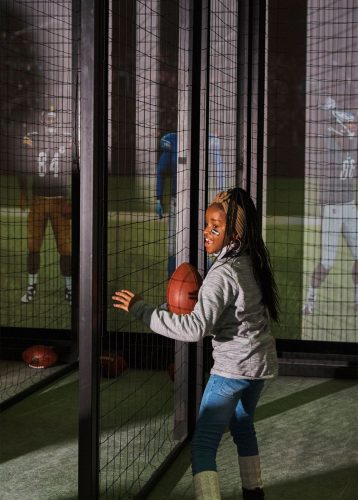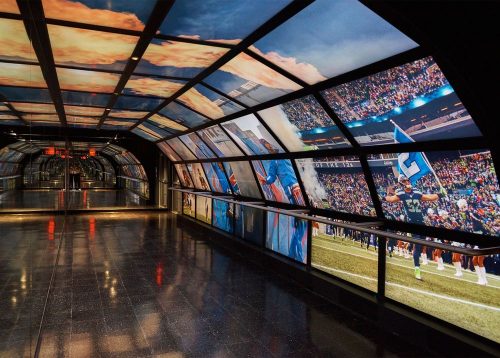In the past three decades, Canada’s Cirque du Soleil has reimagined the notion of a circus by crafting visually arresting aerial extravaganzas that are a world away from P.T. Barnum’s brassy Greatest Show on Earth. Yet at the new Cirque-designed NFL Experience in New York’s Times Square, the closest thing to acrobatics comes from the onscreen football players that audiences witness up close as they’re immersed in the game through a combination of video, sound, moving seats, and even smells.
Many visitors may remember the 11-minute multisensory film “ride” as the highlight of this four-story permanent paean to all things gridiron, slated to open on Nov. 30. But for the 33-year-old Cirque, the joint venture with the National Football League is a chance to showcase how the creative minds behind its trademark shows can be harnessed for different formats as it expands into new markets with the backing of private equity firm TPG Capital LP.
“They can do anything, from a permanent location on Broadway, to a traveling show that pops into towns for two to three weeks, to a show that just appears for a day on a football field,” says NFL Chief Marketing Officer Dawn Hudson. “That is easy to say and very hard to execute.”
The collaboration, which uses digital technology and old-fashioned memorabilia to put visitors in the shoes of an NFL player, is one of several new directions for the Montreal-based company. It’s now offering performances on cruise ships, developing a theme park in Mexico, adding its first show on ice, and expanding in China. Four months after the acquisition in July of music and comedy act Blue Man Group, the company even changed its name to reflect broader ambitions: Cirque du Soleil Entertainment Group.
A major influence behind the transformation is TPG, which has a majority stake in talent management company Creative Artists Agency LLC and co-founded film and television studio STX Entertainment; it hasn’t disclosed its percentage ownership in STX. After acquiring a 55 percent stake in Cirque when founder Guy Laliberté sold 90 percent of the company in a deal with a total value of about $1.4 billion in 2015, the buyout firm overhauled management and helped develop the growth strategy. Seventeen of its 22 highest-ranking executives are new to the company.
“We saw this as ‘Wow, we have this unique capability; we’ve got this global, recognized brand. There’s a lot more we can do,’?” says David Trujillo, a TPG representative on Cirque’s board. Diversifying the company opens up options for its future, including going public, he says.
TPG helped beef up marketing to revitalize sales in Las Vegas, where Cirque runs seven permanent circus and musical shows in casinos. Tickets are now easier to buy on mobile phones, and prices fluctuate with demand. Cirque also has adopted more aggressive social media and corporate sales strategies. All this has helped revenue per available seat rise 20 percent this year, Trujillo says.
An additional 11 shows are on tour in places including Madrid, Shanghai, and Perth, Australia. Cirque’s long-standing relationships with promoters and venues are being used to negotiate new stops for Blue Man shows, says Chief Executive Officer Daniel Lamarre. “Thanks to our distribution strength and our many promoters around the world, we’ve just given the Blue Man Group a new impetus,” he says. “We’re seeing benefits faster than we thought.”
Cirque’s headquarters complex in Montreal brings together creative teams, costume and accessory makers, as well as artists practicing acrobatics or learning how to do their own makeup. Instructions at the gym come in five languages, a reminder there are about 50 nationalities among the 4,000 employees.
Lamarre hasn’t spent much time there lately. In October he traveled twice to China, where Cirque will inaugurate its first permanent mainland show, in Hangzhou, in early 2019. Half the artists in that production will be Chinese. Shanghai-based Fosun International Ltd., which owns 25 percent of Cirque, is helping it expand in China, where one show is already touring. A second show set to hit the road will be Cirque’s adaptation of the film Avatar, which was a huge success in China. The company’s overall ticket sales could double within five years thanks to China, says Lamarre.
New growth avenues would be a welcome addition for Cirque, whose credit rating is “weakly positioned” because of the large amount of debt taken on to complete its leveraged buyout, says Alina Khavulya, an analyst at Moody’s Investors Service Inc. Expansion beyond circus shows could change that. “It’s a broader opportunity,” she says. “I don’t know that it’s less risk.”
Other corners of the Cirque empire have moved beyond their circus roots. At 45 Degrees—a special projects unit named after Montreal’s latitude—the team recently helped design the show of German singing star Helene Fischer, featuring a 30-foot wall on which acrobats perform and a dress made of cascading water. Cirque’s multimedia arm, 4U2C, has worked on the concert tours of Bon Jovi and Justin Timberlake and pitched in on the NFL Experience.
Cirque officials had already collaborated with the NFL on Super Bowl entertainment in 2007 and 2012, but the Times Square project treads new ground. Visitors walk through locker rooms, are taught a play by former NFL coach Jon Gruden’s hologram, see themselves on screens dressed as players, throw real passes in competitions against other visitors, win the Super Bowl, and watch themselves on big screens running before cheering crowds. But nowhere will they see the Cirque name.
That’s just fine with CEO Lamarre, who says the TPG-led owners have helped his team recognize the great potential the company has beyond circus performances. “We believe our expertise is in creation and in production—it’s for live experiences,” he says. “That’s the DNA of Cirque du Soleil.”
{ SOURCE: Bloomberg BusinessWeek | https://goo.gl/mxSnbt }




